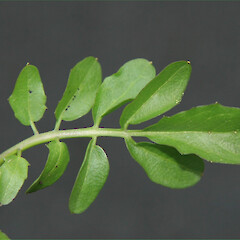Cardamine pratensis
Common name
cuckoo cress, lady’s smock
Family
Brassicaceae
Flora category
Vascular – Exotic
Structural class
Herbs - Dicotyledons other than Composites
NVS code
The National Vegetation Survey (NVS) Databank is a physical archive and electronic databank containing records of over 94,000 vegetation survey plots - including data from over 19,000 permanent plots. NVS maintains a standard set of species code abbreviations that correspond to standard scientific plant names from the Ngä Tipu o Aotearoa - New Zealand Plants database.
CARPRA
Conservation status
Not applicable
Brief description
Upright perennial herb up to 60 cm tall, with divided, watercress-like leaves and groups of pink flowers, c. 1 cm across.
Distribution
Local in North Island, also collected in two South Island localities in Westland and Southland.
Habitat
Wet grass- or sedgeland.
Wetland plant indicator status rating
Information derived from the revised national wetland plant list prepared to assist councils in delineating and monitoring wetlands (Clarkson et al., 2021 Manaaki Whenua – Landcare Research Contract Report LC3975 for Hawke’s Bay Regional Council). The national plant list categorises plants by the extent to which they are found in wetlands and not ‘drylands’. The indicator status ratings are OBL (obligate wetland), FACW (facultative wetland), FAC (facultative), FACU (facultative upland), and UPL (obligate upland). If you have suggestions for the Wetland Indicator Status Rating, please contact: [Enable JavaScript to view protected content]
OBL: Obligate Wetland
Almost always is a hydrophyte, rarely in uplands (non-wetlands).
Detailed description
Perennial herb. Rhizomes present. Stems erect, straight, glabrous, purplish or green, (15)-30-60-(80) cm tall. Lvs thin, green, glabrous, or rarely cauline lvs ciliate. Basal lvs many, pinnate, petiolate; terminal leaflet broadly elliptic, entire, lobed or toothed, shallowly cordate, larger than laterals; lateral leaflets in (3)-4-5-(6) pairs, broadly ovate, lobed or entire, shallowly cordate at base; petiolules < leaflets. Cauline lvs pinnate, shortly petiolate; terminal leaflet larger than laterals, entire, becoming narrow-elliptic to linear, cuneate at base; lateral leaflets in (3)-4-5-(6) pairs, entire, narrow-obovate to linear, cuneate at base, subsessile. Infl. racemose, straight, glabrous, 15-35 cm long. Pedicels glabrous, erecto-patent, 10-20-(30) mm long at fruiting. Sepals glabrous, green or pinkish, with scarious margins, 2.5-4 × 1-1.5-(2) mm. Petals pink (sometimes white), spreading, clawed, 8-11 × 4-6 mm. Stamens 6. Silique pale yellowish green or with purple valves, erect, (10)-15-18-(25) × 1-1.5 mm; valves glabrous; style 1-2 mm long. Seeds reddish brown, elliptic-oblong, not winged, c. 1.5 mm long.
Similar taxa
Unlike any other cresses this species has large pink (rarely white) flowers.
Flowering
Late spring to autumn
Flower colours
Red/Pink, White
Fruiting
Autumn
Life cycle
Seed dispersed by contaminated machinery or footwear.
Year naturalised
1940
Origin
Europe, North America, northern Asia
Reason for introduction
Unknown, possibly an ornamental plant
Control techniques
Not controlled in New Zealand.
Etymology
cardamine: From the Greek name kárdamon, referring to an Indian spice
Attribution
Factsheet prepared by Paul Champion and Deborah Hofstra (NIWA). Prepared by Paul Champion and Deborah Hofstra (NIWA). Features description from Webb et al., (1998).
References and further reading
Clapham, A.R.; Tutin, T.G.; Warburg, E.F. (1962). Flora of the British Isles. Cambridge University Press, Second Edition. 1269pp.
Johnson PN, Brooke PA (1989). Wetland plants in New Zealand. DSIR Field Guide, DSIR Publishing, Wellington. 319pp.
Popay et al (2010). An illustrated guide to common weeds of New Zealand, third edition. NZ Plant Protection Society Inc, 416pp.
Webb, C.J.; Sykes, W.R.; Garnock-Jones, P.J. (1988). Flora of New Zealand Volume 4: Naturalised pteridophytes, gymnosperms, dicotyledons. Botany Division, DSIR, Christchurch.








